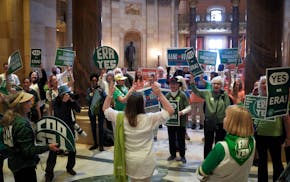Opinion editor's note: Star Tribune Opinion publishes a mix of national and local commentaries online and in print each day. To contribute, click here.
•••
It's no surprise that President Joe Biden's administration has hatched a plan to push more electric vehicles into the mainstream. An Environmental Protection Agency plan calls for electric vehicles to compose two-thirds of new car sales by 2032, largely by making gasoline cars too costly to buy. It is, in effect, a tacit admission that EVs aren't yet ready to compete with entry-level gasoline cars on their own merits.
For many, this is hard to believe. During the past decade, we've been told that the electric vehicle is on the cusp of broad adoption, awaiting only a few minor tweaks to its battery. But the tweaks haven't sufficed, and the modern electric car is still predominantly a product for the wealthy. EVs, it seems, still can't compete with the low-priced Civics and Corollas of the world. And those vehicles continue to make up a large percentage of global auto sales.
In popular culture, we've come to believe that the battery-powered car is a new idea, rapidly progressing. But the truth is that the EV is neither new nor rapid. This year, the manufacturable electric vehicle will celebrate its 139th birthday, having been invented in the United Kingdom in 1884. During those 139 years, it has been surpassed by many technologies that actually were evolving rapidly. Those include the airplane, television, transistor and electric refrigerator.
It could be argued, of course, that the electric car was slowed by a half-century hiatus. But even after its return to the stage in the late 1960s, its evolution has been excruciatingly slow. Three fledgling inventions of the 1970s and '80s — the personal computer, cellphone and internet — have all sped past it. All three now serve billions of people, while the EV still attempts to struggle to its feet. Even the lithium-ion battery, which is the electric car's saving grace, is rapidly reaching middle-age, having turned 50 years old last year.
The point is that the EV's evolution has been slow. And it may continue to be slow. It goes without saying that someone in the Biden administration recognized this and decided to push the panic button. The U.S. Energy Information Administration in March released a report stating that EV sales would reach just 15% by 2030 and just 19% by 2050.
But by tilting the playing field, we would now have a different ballgame. For many years, it's been assumed that the electric car would come down in cost until it reached price parity with the gasoline car. But the new EPA mechanism calls for the reverse: reaching parity, not by lowering the price of the EV, but by raising the price of the gasoline car.
The rationale for this is climate change, of course. The more honest message would be, "We want to curb greenhouse gas production, and we know we can't compete with your Toyota Corolla, so we're going to force you to buy an electric vehicle." But we'll never hear that. Instead hear about how great this transition will be for consumers.
But it won't be, especially for working-class buyers of entry-level trucks and sedans. Unlike the wealthy, many of whom buy EVs to display their values, these buyers will be hurt. Low-end gasoline vehicles in the $25,000 range will almost certainly rise in cost — a lot.
All of this could be avoided, of course, if the EV were able to compete with gasoline cars on an initial-cost basis. But there is no schedule for this. Past predictions have been repeatedly inaccurate, sometimes wildly so. The electric car, it seems, has always been five years away from glory.
So now we have an EPA plan to solve this dilemma. By handicapping the competition.
Charles J. Murray is a Chicago-area author who writes about the history of technology. His latest book is "Long Hard Road: The Lithium-Ion Battery and the Electric Car."

Let voters decide on Equal Rights Amendment

Readers Write: Graduation, child care, midwifery, Timberwolves fans

How to avoid an Uber/Lyft disaster



